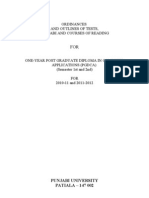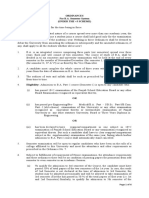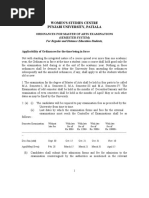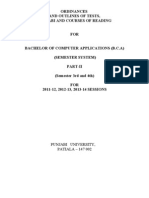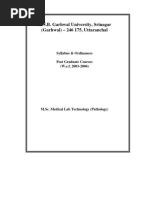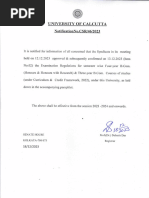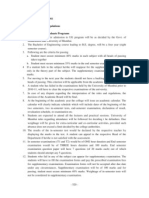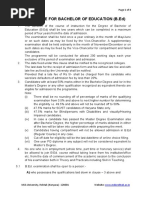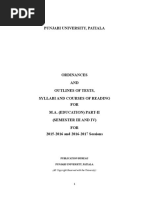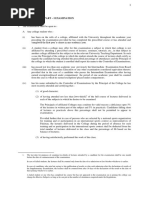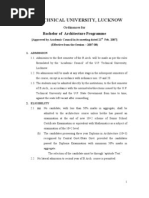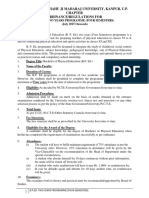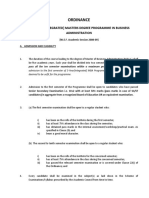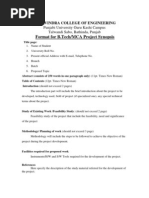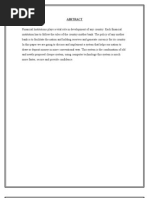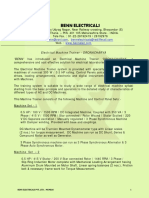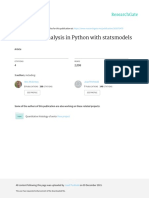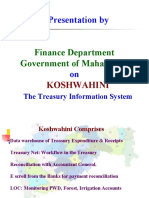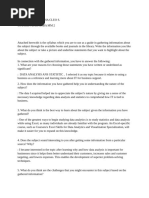0 ratings0% found this document useful (0 votes)
252 viewsBACHELOR OF COMPUTER APPLICATIONS (B.C.A.) PART-I (Semester I & II) PDF
BACHELOR OF COMPUTER APPLICATIONS (B.C.A.) PART-I (Semester I & II) PDF
Uploaded by
Manish GoyalThis document outlines the ordinances and regulations for the Bachelor of Computer Applications (B.C.A.) degree program offered by Punjabi University. Some key points include:
- The B.C.A. program is spread over six semesters taken over three academic years. Exams for semesters 1, 3, and 5 are in November/December, and exams for semesters 2, 4, and 6 are in May/June.
- Students must attain a minimum of 35% marks in each subject as well as in internal and university assessments separately in order to pass.
- Students failing in no more than two subjects can reappear for exams within two attempts. Those failing
Copyright:
Attribution Non-Commercial (BY-NC)
Available Formats
Download as PDF, TXT or read online from Scribd
BACHELOR OF COMPUTER APPLICATIONS (B.C.A.) PART-I (Semester I & II) PDF
BACHELOR OF COMPUTER APPLICATIONS (B.C.A.) PART-I (Semester I & II) PDF
Uploaded by
Manish Goyal0 ratings0% found this document useful (0 votes)
252 views26 pagesThis document outlines the ordinances and regulations for the Bachelor of Computer Applications (B.C.A.) degree program offered by Punjabi University. Some key points include:
- The B.C.A. program is spread over six semesters taken over three academic years. Exams for semesters 1, 3, and 5 are in November/December, and exams for semesters 2, 4, and 6 are in May/June.
- Students must attain a minimum of 35% marks in each subject as well as in internal and university assessments separately in order to pass.
- Students failing in no more than two subjects can reappear for exams within two attempts. Those failing
Original Description:
BACHELOR OF COMPUTER APPLICATIONS (B.C.A.) PART-I (Semester I & II)
Original Title
BACHELOR OF COMPUTER APPLICATIONS (B.C.A.) PART-I (Semester I & II).pdf
Copyright
© Attribution Non-Commercial (BY-NC)
Available Formats
PDF, TXT or read online from Scribd
Share this document
Did you find this document useful?
Is this content inappropriate?
This document outlines the ordinances and regulations for the Bachelor of Computer Applications (B.C.A.) degree program offered by Punjabi University. Some key points include:
- The B.C.A. program is spread over six semesters taken over three academic years. Exams for semesters 1, 3, and 5 are in November/December, and exams for semesters 2, 4, and 6 are in May/June.
- Students must attain a minimum of 35% marks in each subject as well as in internal and university assessments separately in order to pass.
- Students failing in no more than two subjects can reappear for exams within two attempts. Those failing
Copyright:
Attribution Non-Commercial (BY-NC)
Available Formats
Download as PDF, TXT or read online from Scribd
Download as pdf or txt
0 ratings0% found this document useful (0 votes)
252 views26 pagesBACHELOR OF COMPUTER APPLICATIONS (B.C.A.) PART-I (Semester I & II) PDF
BACHELOR OF COMPUTER APPLICATIONS (B.C.A.) PART-I (Semester I & II) PDF
Uploaded by
Manish GoyalThis document outlines the ordinances and regulations for the Bachelor of Computer Applications (B.C.A.) degree program offered by Punjabi University. Some key points include:
- The B.C.A. program is spread over six semesters taken over three academic years. Exams for semesters 1, 3, and 5 are in November/December, and exams for semesters 2, 4, and 6 are in May/June.
- Students must attain a minimum of 35% marks in each subject as well as in internal and university assessments separately in order to pass.
- Students failing in no more than two subjects can reappear for exams within two attempts. Those failing
Copyright:
Attribution Non-Commercial (BY-NC)
Available Formats
Download as PDF, TXT or read online from Scribd
Download as pdf or txt
You are on page 1of 26
ORDINANCES
AND OUTLINES OF TESTS,
SYLLABI AND COURSES OF READING
FOR
BACHELOR OF COMPUTER APPLICATIONS (B.C.A)
(SEMESTER SYSTEM)
PART-I
(Semester Ist and IInd)
FOR
2013-14 & 2014-15, 2015-16 SESSIONS
PUNJABI UNIVERSITY,
PATIALA 147 002
2
ORDINANCES
(FOR B.C.A. UNDER THE +3 SCHEME)
Applicability of Ordinances for the time being in force
Notwithstanding the integrated nature of a course spread over more than one academic year,
the ordinances in force at the time a student joins a course shall hold good only for the
examination held during or at the end of the academic year. Nothing in these Ordinances shall
be deemed to debar the University from amending the ordinances subsequently and the
amended ordinances, if any, shall apply to student whether old or new.
1. The course for the Degree of B.C. A. (Bachelor of Computer Applications) shall be
spread over Three academic years to be called Semester I, II, III, IV, V and VI. The
examination for the I, III and V semesters shall be held in the month of
November/December and for the II, IV and VI semesters in the month of May/June or
on such other dates as may be fixed by the Academic Council.
2. The outlines of tests and syllabi shall be such as prescribed by the Academic Council
from time to time.
3. The candidates will be required to pay examination fees as prescribed by the
University from time to time.
4. Application for admission to the examination shall be made on the prescribed form
countersigned by the authorities as mentioned in the relevant ordinances. The last date
by which admission forms and fees must reach the Registrar shall be as follows:
Annual
Examination
Without
late fee
With late
fee of Rs.
100/-
With late
fee of Rs.
300/-
With late fee
of Rs. 500/-
With late fee
of Rs. 1000/-
I, III and V
semester
Regular and
Re-appear
Candidates
Sept. 30
Oct. 15
Oct. 31
Up to 21 days
before the
commenceme
nt of the
examination
(written or
practical
whichever is
earlier)
Up to ten
days before
the
commenceme
nt of the
examination
(Written or
practical
whichever is
earlier) with
the approval
of the Vice-
Chancellor
II, IV and VI
semester
Regular and
Re-appear
Candidates
Feb. 28
Mar. 15
Mar. 31
-do-
-do-
5. The medium of instructions and examination shall be English only.
6. In each course 20% of the total marks are assigned to the internal assessment and 80%
marks in the University.
3
7. (a) The minimum number of marks required to pass the examination shall be 35%
in each paper by obtaining minimum 35% of the marks in the Internal
assessment and 35% of the marks in the University examination separately for
each paper.
(b) When a candidate has failed or placed under re-appear in the University
examination, but passes in internal assessment, the marks in the continuous
assessment shall be carried for subsequent examinations.
8. (a) A candidate who fails not in more than two papers may be declared `re-
appear' in those papers at a subsequent examination within two chances and
may be permitted to re-appear in those papers.
The examination of the reappear papers of odd semester will be held with
regular examination of the odd semester and reappear examination of even
semester will be held with regular examination of even semester. But if a
candidate is placed under reappear in the last semester of the course, he will be
provided chance to pass the reappear with the examination of the next
semester, provided his reappear of lower semester does not go beyond next
semester.
(b) If a candidate fails in more than two papers, he/she will be declared `fail'. If
such candidate has taken provisional admission to next semester before the
declaration of result of the previous semester, his/her admission shall be
cancelled immediately on declaration of the result of previous semester.
He/She will have to clear the examination for the very semester as a private
candidate along with the regular students of that semester.
9. A Candidate shall be allowed to join:
(i) First Semester:
Provided that he/she has passed at least, one academic year previously, the +2
examination of Punjab School Education Board, or any other examination
recognised as equivalent thereto.
(ii) Second Semester:
Provided that he/she has undergone a regular course of studies of first semester
as provided under the regulations and fulfils the conditions as laid in ordinance
7 and 8 above.
(iii) Third Semester:
Provided that he/she has undergone a regular course of studies of First and
Second semesters as provided under the regulations in sequential order and
fulfils the conditions as laid in ordinance 7 and 8 above.
4
(iv) Fourth Semester:
Provided that he/she has undergone a regular course of studies of First, Second
and Third semesters as provided under the regulations in sequential order and
has passed the First Semester Examination as a whole, and fulfils the
conditions as laid in ordinance 7 and 8 above.
(v) Fifth Semester:
Provided that he/she has undergone a regular course of studies of First,
Second, Third and Fourth semesters as provided under the regulations in
sequential order and has passed the First and Second Semester examinations as
a whole, respectively; and fulfils the conditions as laid in ordinance 7 and 8
above.
(vi) Sixth Semester:
Provided that he/she has undergone a regular course of studies of First,
Second, Third, Fourth and Fifth semesters as provided under the regulations in
sequential order and has passed First, Second and Third Semester
examinations as a whole, respectively and fulfils the conditions as laid in
ordinance 7 and 8 above.
10. Three weeks after the termination of examination or as soon thereafter as possible, the
Registrar shall publish the result of the candidates. Each candidate shall receive a
certificate indicating details of marks obtained in each examination. Successful
candidates at the end of Semester-VI examination shall receive a degree stating the
division according to ordinance 15.
11. The minimum number of marks required to pass the examination in each Part shall be
35% in each subject, provided that in subject with practical the percentage shall be
required separately in written and practical/lab work. The candidate shall also be
entitled to grace marks as admissible under the ordinances relating to the `GENERAL
GRACE MARKS`.
12. The examination in Semester I, II, III, IV, V and VI shall be open to a person who
satisfies the requirements at A and B as given below:
'A'
The first semester examination shall be open to a person: Has passed at least, one
academic year previously, the +2 examination of Punjab School Education Board, or
any other examination recognised as equivalent thereto and fulfils the conditions
provided in ordinance 12 'B'.
Semesters I I , I I I , I V, V and VI examinations shall be open to a person who has
passed the previous semester examination/s or fulfils the conditions provided in
ordinance 12 'B'.
'B'
(I) (a) Has remained on the rolls of a college admitted to the privileges of the
University throughout the academic year preceding the examination.
5
(b) (i) Every candidate will be required to attend a minimum of 75% lectures
delivered to that class in each paper.
(ii) In case of students, whose names are struck off from the rolls due to non-
payment of fee, and is admitted later on, his/her attendance shall not be
counted for that period.
(iii) The shortage in the attendance to lectures by the candidate will be condoned as
per rules made by the University from time to time.
OR
(II) Has completed the prescribed course of instructions for the examination but has not
appeared or having appeared has failed in the examination. Such a candidate may
appear in any subsequent semester examination with in the period prescribed in the
Statues.
13. The pass students or the students declared reappear in not more than two papers in B.
C. A. Part-I & II from Punjab University, Guru Nanak Dev University and Punjab
Technical University shall be treated at par with the corresponding students of this
University, only if he/she will have cleared the deficiency papers as a supplementary.
Such Candidates will be given two attempts. The marks secured by such students shall
be scaled to the marks allotted to each subject by this University.
14. Candidates who have not studied the subject of Punjabi up to matriculation shall be
required to pass Punjabi either up to matriculation standard or Punjabi Preveshka
during the course period to qualify for the award of degree.
15. The successful candidates shall be classified on the basis of aggregate marks secured
in B. C. A. Part-I, Part-II and III taken together as under:
(a) 75% or more in First division with Distinction.
(b) 60% or more but less than 75% in the First division.
(c) 50% or more but less than 60% in the Second division.
(d) 35% or more but less than 50% in the Third division.
16. A University medal will be awarded to student who secures First position in the
University on the basis of the marks obtained in all three parts taken together. The
general rules and conditions of the University for the Award of medal/prizes etc. will
be applicable in the award of University medal to the topper of this examination.
17. A candidate who is declared reappear or fail at any stage shall not be eligible for
scholarship, Prize or Medal.
6
SYLLABUS
BACHELOR OF COMPUTER APPLICATIONS
OUTLINE OF PAPERS AND TESTS
for
B.C.A. First Year First Semester
2013-14 & 2014-15 Sessions
Code
Title of Paper
Hours
per
Week
University
Examination
Internal
Assessment
Max.
Marks
Exam.
Duratio
n Hours
BCA-111 General English I 4 80 20* 100 3
BCA-112 Punjabi (Compulsory) or
Punjabi Compulsory (Mudla Gyan)
**
4 40 10 50 3
BCA-113 Fundamentals of Information
Technology
4 80 20 100 3
BCA-114 Basic Mathematics 4 80 20 100 3
BCA-115 Programming Fundamentals using C 4 80 20 100 3
BCA-116 Software Lab I (based on paper
BCA-115: Programming
Fundamentals using C)
8 60 40 100 3
Total 420 130 550
Note:
1. The break up of marks for the practical will be as under:
i. Internal Assessment 40 Marks
ii. Viva Voce (External Evaluation) 20 Marks
iii. Lab Record Program Development and Execution(External
Evaluation)
40 Marks
2. The break up of marks for the internal assessment for theory except BCA-111 will be as under:
i.
One or two tests out of which minimum one best will be
considered for assessment.
15 Marks
ii.
Attendance, Class participation and behaviour 5 Marks
*The break up of marks for the internal assessment for BCA-111: General English I will be as under:
i. Formal assessment through Interview/Self Introduction/Recitation
etc.
10 Marks
ii. Conversation Skills (particularly listening and speaking to be
evaluated through oral examination)
5 Marks
iii. Attendance, Class participation and behaviour 5 Marks
** Only those students who have not studied Punjabi up to matriculation can opt for
Punjab Compulsory (Mudla Gyan). The code for the paper is same.
7
OUTLINE OF PAPERS AND TESTS
for
B.C.A. First Year Second Semester
2013-14 & 2014-15 Sessions
Code
Title of Paper
Hours
per
Week
University
Examination
Internal
Assessment
Max.
Marks
Exam.
Duratio
n Hours
BCA-121 General English II 4 80 20* 100 3
BCA-122 Punjabi (Compulsory) or
Punjabi Compulsory (Mudla Gyan)
**
4 40 10 50 3
BCA-123 Digital Electronics 4 80 20 100 3
BCA-124 Data Structures 4 80 20 100 3
BCA-125 Mathematical Foundation of
Computer Science
4 80 20 100 3
BCA-126 Software Lab II (based on BCA-
124: Data Structures)
8 60 40 100 3
Total 420 130 550
Note:
1. The break up of marks for the practical will be as under:
i. Internal Assessment 40 Marks
ii. Viva Voce (External Evaluation) 20 Marks
iii. Lab Record Program Development and Execution(External
Evaluation)
40 Marks
2. The break up of marks for the internal assessment for theory papers except BCA-121 will be as under:
i. One or two tests out of which minimum one best will be
considered for assessment.
15 Marks
ii. Attendance, Class participation and behaviour 5 Marks
*The break up of marks for the internal assessment for BCA-121: General English II will be as under:
i. Formal assessment through Interview/Self Introduction/Recitation
etc.
10 Marks
ii. Conversation Skills (particularly listening and speaking to be
evaluated through oral examination)
5 Marks
iii. Attendance, Class participation and behaviour 5 Marks
8
BCA-111: General English I
Max Marks: 80 Maximum Time: 3 Hrs.
Min Pass Marks: 35% Lectures to be delivered: 45-55 Hrs
General English has been designed to develop the students general competence in English.
The overall aims of the course are to enable the learner to use English effectively for study
purpose across the curriculum and develop and integrate the use of the four language skills,
i.e. listening, speaking, reading and writing.
Texts Prescribed for Grammar and Vocabulary:
W. Standard Allen: Living English Structure (Orient Longman)
Wilford D. Best: The Students Companion (Rupa)
SECTION A: Comprehension 15 Marks
One unseen passages of 250-300 words in length with a variety of comprehension questions
including 05 marks for word-attack skills such as word formation and inferring meaning,
finding opposites etc. The passage can be a factual passage (e.g., instruction, description,
report etc.) or a literary passage (e.g., extract from fiction, drama, poetry, essay or biography),
or a discursive passage involving opinion, (argumentative, persuasive or interpretative text).
SECTION B: Vocabulary 15 Marks
Change the Number (attempt any 5 out of 7)( marks each) 2 marks
Change the Gender (attempt 5 any out of 7)( marks each) 2 marks
Words commonly mis-spelt (correct any 5 out of 7)( marks each) 2 marks
Antonyms(attempt any 5 out of 7) ( marks each) 2 marks
Synonyms (attempt any 5 out of 7) ( marks each) 2 marks
Fill up using correct determinant (attempt any 5 out of 7) ( marks each) 2 marks
SECTION B: Grammar 25 Marks
Filling up the correct form types of the tense in the sentence: present/ past
/future tense with simple/continuous/perfect/ perfect continuous forms
(Attempt any 5 out of 7)
5 marks
Reordering word groups in the sentence to make a meaning full sentence.
(Attempt any 5 out of 7)
5 marks
Identify various types of clauses and phrases in the sentence: finite and
non-finite subordinate clauses: noun clauses and phrases, adjective clauses
and phrases, adverb clauses and phrases(Attempt any 5 out of 7)
5 marks
Conversion among various types of sentences: affirmative, interrogative
sentences, negation, exclamations (Attempt any 5 out of 7)
5 marks
Write meaning of given word and using in the sentence (Attempt any 5 out
of 7)
5 marks
9
SECTION D: Composition 25 Marks
Composition on a given topic/title based on any current social,
environment, health issues. Students will be asked to attempt any one out
of 4-5 options with word limit 150-175.
10 Marks
Formal Letter Writing (invitation, accepting/rejecting an invitation,
apology, welcome, thanking complements )
7 Marks
Translating a paragraph from Punjabi/Hindi to English (50-75 words) 7 Marks
10
BCA-112 : u=l ==l
n . m == ~= u (l0al +u)
(lea= +u)
== ~ln~u ulal~a (+ ulal~a u=l o-=) un oa =el ~= . u=ln=
ln=n ~= uu n==
+ u=l =l u un== nu== == lnm ul, u=n u=l=n l0a,
u=l =lalnl, ul~=1
: ua au
. l~=a
(0) l~=a = l~=l ==
(~) n= nal~ ~= au=a
+ == + = ~na = c un
~=a ~= uua n a =el o=le=
l=n =l= = na = 0n = ln n= (= lu le=) : ~=
l=n au (=oal, =u) = ln n= = na (= lu le=) : ~=
(0) ua au (l= ln = = le= =a =el ~lu~ =a) : ~=
a . 0= l== l~=a = ln=n = ~na 0= aa=l= ua un uc
=aa, = = 0=a =a =el l=o =a1 : ~=
(0) == + =l uun== lu ua = = lola= l~=a= ln=na1 leo
un . lu lanla= l~=a = u u 0= ol ~nla= oa1
41=4 ~=
(~) == + = ~na = + c un uc =a1 41=4 ~=
11
u=l ==l ( = la~)
n na u a=l (n na ulo=)
:u+.++, :u+++ n n =el
n . m == ~= u (l0al +u)
~=al ==a +u
oal ==a +u
=an n c ulal~a u=l o-= un oa =el ~= . u=ln=
+ aaul a= = =uau n
(0) ~ua lnlu~ =a=la = a= ~ua1
(~) ~ua a=a ~ua au = =ua = l=1
: aaul ~ua = u =l nl~ = un
(0) na = l~= aal=a = lnn= = 0ua1
(~) na nu= ~ua = nl~ =l uca = a=1
(e) l~= nu= ~ua = nl~ =l uca = a=1
(n) =a=a =l uca = a=1
(o) =aua =l uca1
. l=ul = ~ua =l a= = l=
(0) ua = ~n ~ua =l uca = a=1
(~) na nu= ~ua =l uca = a=
(e) na o= =l uca = a=1
(n) =a = na o= =l n=l a=1
(o) =a =l l~= nu= = a=1
+ u=l n==l = =a uca
(0) laa=l
(~) o-= = l=
(e) aa =
(n) un ucl~ =
(o) u=l lan== un =l n==l
(=) ma= n= =l n==l
12
uua na =el o=le=
oa aa _ aa ~= =l u=lln= l==l =1
(ll=~al ulo=l a aaul l=ul lnu ao o1 o n== o ll=~al u=l
an = ~=a oa, n un = una ll=~al~ =l nl _ ln~ lu alu~
=1)
nole= u n==
+ nl= lnm nn, ~C u=l lnule, u=l=n l0a, u=l =lalnl,
ul~=, :uu1 (lo=l = u=l lnua =el)
: nl= lnm nn, aaul lnu, u=l=n l0a, u=l =lalnl, ul~=,
:u++1 (~ aa=l = u=l lnua =el)
. nl= a oal, u=l lnule, u=l=n l0a, u=l =lalnl, ul~=,
:uu: (lo=l)
+ a=l =a lnm, u=l la~ nlal (=lu0a ~u=l=n =a ~a lu
u=l), u=l=n l0a, u=l =lalnl, ul~=, :u++1
5. Hardev Bahri, Teach Yourself Punjabi, Publication Bureau, Punjabi University, Patiala,
2011.
6. Henry A. Gleason and Harjeet Singh Gill, A Start in Punjabi, Publication Bureau, Punjabi
University, Patiala, 1997.
7. Ujjal Singh Bahri and Paramjit Singh Walia, Introductory Punjabi, Publication
Bureau,
Punjabi University, Patiala, 2003.
13
BCA-113: Fundamentals of Information Technology
Max Marks: 80 Maximum Time: 3 Hrs.
Min Pass Marks: 35% Lectures to be delivered: 45-55 Hrs
INSTRUCTIONS FOR THE PAPER SETTER
The question paper will consist of three sections: A, B & C. Sections A & B will have four questions
each from the respective sections of the syllabus carrying 15 marks for each question. Section C will
have 10 short-answer type questions carrying a total of 20 marks, which will cover the entire syllabus
uniformly..
INSTRUCTIONS FOR THE CANDIDATES
Candidates are required to attempt two questions each from the sections A & B of the question paper
and the entire section C.
SECTION-A
Computer Fundamentals: Block diagram of a computer, characteristics of computers and
generations of computers.
Input Devices: Keyboard, Mouse, Joy tick, Track Ball, Touch Screen, Light Pen, Digitizer,
Scanners, Speech Recognition Devices, Optical Recognition devices OMR, OBR, OCR
Output Devices: Monitors, Impact Printers - Dot matrix, Character and Line printer, Non
Impact Printers DeskJet and Laser printers, Plotter.
Memories: Main Memories - RAM, ROM and Secondary Storage Devices - Hard Disk,
Compact Disk, DVD.
Computer Languages: Machine language, assembly language, high level language, 4GL,
Introduction to Compiler, Interpreter, Assembler, System Software, Application Software.
SECTION-B
Number System: Non-positional and positional number systems, Base conversion, Concept
of Bit and Byte, binary, decimal, hexadecimal, and octal systems, conversion from one system
to the other.
Binary Arithmetic: Addition, subtraction and multiplication., 1s complement, 2s
complement, subtraction using 1s complement and 2s complement.
Operating System: Batch, Multiprogramming, time-sharing, on-line and real time operating
system, Multi-processor, Multi-tasking.
Computer Network: Network types, network topologies.
Introduction to the Concept to Internet: Evolution of Internet, Internet Applications,
WWW, E-mail, FTP, TELNET, Web Browsers.
Applications of Information Technology and Trends: IT in Business and Industry, IT in
Education & training, IT in Science and Technology, IT and Entertainment, Current Trends in
IT Application - AI, Virtual Reports, voice recognition, Robots, Multimedia Technology.
References:
1 P.K. Sinha and P. Sinha, Foundations of Computing, First Edition, 2002, BPB.
2 Chetan Srivastva, Fundamentals of Information Technology, Kalyani Publishers.
3 Turban Mclean and Wetbrete, Information Technology and Management, Second
Edition, 2001, John Wiley & Sons.
4 Satish Jain, Information Technology, BPB, 1999.
14
BCA-114: Programming Fundamentals using C
Max Marks: 80 Maximum Time: 3 Hrs.
Min Pass Marks: 35% Lectures to be delivered: 45-55 Hrs
INSTRUCTIONS FOR THE PAPER SETTER
The question paper will consist of three sections: A, B & C. Sections A & B will have four questions
each from the respective sections of the syllabus carrying 15 marks for each question. Section C will
have 10 short-answer type questions carrying a total of 20 marks, which will cover the entire syllabus
uniformly..
INSTRUCTIONS FOR THE CANDIDATES
Candidates are required to attempt two questions each from the sections A & B of the question paper
and the entire section C.
Section - A
Programming Process: Problem definition, Algorithm development, Flowchart, Coding,
Compilation and debugging.
Basic structure of C program: History of C, Structure of a C program, Character set,
Identifiers and keywords, constants, variables, data types.
Operators and expressions: Arithmetic, Unary, Logical, Relational operators, assignment
operators, Conditional operators, Hierarchy of operations type conversion.
Control statements: branching statements ( if, if else, switch), loop statements (for, while
and do-while), jump statements (break, continue, goto), nested control structures.
Functions: Library functions and user defined functions, prototype, definition and call,
formal and actual arguments, local and global variables, methods of parameter passing to
functions, recursion.
I/O functions: formatted & unformatted console I/O functions
Section - B
Storage Classes: automatic, external, static and register variables.
Arrays: One dimensional and two dimensional arrays
Declaration, initialization, reading values into an array, displaying array contents
Strings: input/output of strings, string handling functions (strlen, strcpy, strcmp, strcat &
strrev), table of strings.
Structures and unions: using structures and unions, comparison of structure with arrays and
union.
Pointers: pointer data type, pointer declaration, initialization, accessing values using pointers,
pointers and arrays.
Introduction to Files in C: opening and closing files. Basic I/O operation on files.
Text Book:
1 E. Balagurusamy, Programming in C, Tata McGraw Hill.
References:
1 Kernighan and Ritchie, The C Programming Language, PHI.
2 Byron Gotfried, Programming in C.
3 Kamathane, Programming in C, Oxford University Press.
15
BCA-115: Basic Mathematics
Max Marks: 80 Maximum Time: 3 Hrs.
Min Pass Marks: 35% Lectures to be delivered: 45-55 Hrs
INSTRUCTIONS FOR THE PAPER SETTER
The question paper will consist of three sections: A, B & C. Sections A & B will have four questions
each from the respective sections of the syllabus carrying 15 marks for each question. Section C will
have 10 short-answer type questions carrying a total of 20 marks, which will cover the entire syllabus
uniformly..
INSTRUCTIONS FOR THE CANDIDATES
Candidates are required to attempt two questions each from the sections A & B of the question paper
and the entire section C.
Section - A
Complex Numbers: Complex Numbers in the form of a+ib, Real and Imaginary parts of a complex
number, Complex conjugate, algebra of complex numbers, square roots of a complex number, cube
roots of unity.
Quadratic Equations: Solutions of Quadratic equations (with real and complex coefficients),
Relations between roots and coefficients, Nature of roots, Equations reducible to quadratic equations.
Sequence and Series: Sequence and series, Arithmetic Progression (A.P.), Arithmetic Mean (A.M.),
nth term, sum to n terms of an AP, Geometric Progression (G.P.), general term of GP, sum to n terms
of a GP, Infinite GP and its sum, Geometric mean (G.M.), Sum to n terms of special series n,
n
2
,n
3
Section - B
Inequalities:Solution of Linear and Quadratic Inequalities.
Counting: The basics of counting, Permutation and combinations.
Binomial Theorem: Expansion, General term, middle term, Independent term.
Cartesian System of Rectangular Coordinates: Cartesian coordinate system, distance formula,
section formula, centroid and incentre, area of triangle, condition for collinearities of three points in a
plane.
Straight Line: Slope of a line, parallel and perpendicular lines, Equation of line in different forms,
distance of a point from a line.
Circle: Slandered form of equation of circle, General form, diameter form, three point form,
Intersection of a line and a circle.
Text Book:
1. NCERT Textbooks of Mathematics for +1 and +2.
16
BCA-116: Software Lab I
(Based on paper BCA-114: Programming Fundamentals using C)
Max Marks: 100 Maximum Time: 3 Hrs.
Min Pass Marks: 35% Practical Sessions to be conducted: 12 periods per week)
This laboratory course will comprise as exercises to supplement what is learnt under paper
BCA-114: Programming Fundamental using C. Students are required to develop the
following programs with internal documentation:
1. Operators and data types in C
a) Write a program to print the size of all the data types supported by
C and its range.
b) Write a program to convert temperature from Fahrenheit to Celsius.
c) Write a program to find simple interest and compound interest.
2. Control statements
a) Write a program to check whether the given number is a even number
or not.
b) Write a program to accept three numbers and find the largest among
them.
c) Write a program to count the different vowels in a line of text
using switch.
d) Write a program to accept two numbers and perform various arithmetic
operations (+, -, *, /) based on the symbol entered.
e) Write a program to find factorial of a number.
f) Write a program to check whether a number is prime or not.
g) Write a program to print all prime numbers between any 2 given
limits.
h) Write a program to check whether a number is palindrome or not.
i) Write a program to print all the Armstrong numbers between any 2
given limits.
4. Arrays and strings
a) Write a program to find largest element in an array.
b) Write a program to find sum and average of numbers stored in an
array.
c) Write a program to check whether a string is a Palindrome.
d) Write a program to perform matrix addition.
e) Write a program to perform matrix multiplication.
6 Functions and recursion
a) Write a program to find the roots of a quadratic equation using
function.
b) Write a recursive program to find the factorial of a number.
c) Write a recursive program to find the nth Fibonacci number.
7. Structures and unions
a. Create an employee structure and display the same.
b. Create a student database storing the roll no, name, class etc and sort
by name.
8. Aim: To learn about pointers
a. Write a function to swap two numbers using pointers
b. Write a program to access an array of integers using pointers
17
9. Aim: To learn about Files
a. Create a file and store some records in it. Display the contents of the
same. Count numbers of characters, words and lines in the file.
The break up of marks for the practical will be as under
i. Internal Assessment 40 Marks
ii. Viva Voce (External Evaluation) 20 Marks
iii. Lab Record, Program Development and
Execution(External Evaluation)
40 Marks
18
BCA-121: General English II
Max Marks: 80 Maximum Time: 3 Hrs.
Min Pass Marks: 35% Lectures to be delivered: 45-55 Hrs
General English has been designed to develop the students general competence in English.
The overall aims of the course are to enable the learner to use English effectively for study
purpose across the curriculum and develop and integrate the use of the four language skills,
i.e. listening, speaking, reading and writing.
Texts Prescribed for Grammar and Vocabulary:
W. Standard Allen: Living English Structure (Orient Longman)
Wilford D. Best: The Students Companion (Rupa)
SECTION A: Comprehension 15 Marks
One unseen passages of 300-350 words in length with a variety of comprehension questions
including 05 marks for word-attack skills such as word formation and inferring meaning,
finding opposites etc. The passage can be a factual passage (e.g., instruction, description,
report etc.) or a literary passage (e.g., extract from fiction, drama, poetry, essay or biography),
or a discursive passage involving opinion, (argumentative, persuasive or interpretative text).
SECTION B: Vocabulary 20 Marks
Fill up using correct form of verb(Attempt any 5 out of 7)( marks each) 2 marks
Usage of the adverb, adjective etc. (Attempt any 5 out of 7)( marks
each)
2 marks
Write Antonym of the given word and use both the given word and its
antonym in the single sentence clarifying meaning and usage(Attempt any
5 out of 7)
5 marks
Give different meanings to Synonyms and use them in sentences (Attempt
any 5 out of 7)
5 marks
Give meaning and make sentences for idioms (Attempt any 5 out of 7) 5 marks
SECTION C: Grammar 20 Marks
Conversion among various types of the tenses in the sentence: present/
past /future tense with simple/continuous/perfect forms (Attempt any 5 out
of 7)
5 marks
Conversion between Direct/Indirect speech (Attempt any 5 out of 7) 5 marks
Conversion between active/passive voice (Attempt any 5 out of 7) 5 marks
Conversion among various types of sentences: affirmative, interrogative
sentences, negation, exclamations (Attempt any 5 out of 7)
5 marks
19
SECTION D: Composition 25 Marks
Composition on a given topic/title based on any current social,
environment, health issues. Students will be asked to attempt any one out
of 4-5 options with word limit 150-175.
10 Marks
Formal Letter Writing (Applying for a job, making a complaint, asking for
information )
7 Marks
Translating a paragraph from Punjabi/Hindi to English (50-75 words) 7 Marks
20
BCA : 122 u=l ==l
n na = =
n . m == ~= u (l0al +u)
(lea= +u)
== ~ln~u ulal~a (+ ulal~a u=l o-=) un oa =el ~= . u=ln=
ln=n ~= uu n==
+ ~l= ul= lu=a
: lul u=a
. l~=a
(0) an al~ an = =n=l au, an = 0uan = ~=a ~= ~=a
nn, u=l 0uan = uca lu
(~) aaul l=ul ~= n= =
+ == + = ~na = c un
~=a ~= uua n a =el o=le=
+ = = na = 0n = ln n=, u=a 0nal (= lu le=) +o ~=
: lul u=a : ~=
. a . 0= l== l~=a = ln=n = ~na 0= aa=l= ua un uc
=aa, = = 0=a =a =el l=o =a1 : ~=
+
(0) == + =l uun== lu ua = = lola= l~=a= ln=na1 leo
un + lu lanla= l~=a = u u 0= ol ~nla= oa1
41=+ ~=
(~) == + = ~na = + c un uc =a1 41=4 ~=
21
u=l ==l ( = la~)
n na u a=l (n na = =)
:u+.++, :u+++ n n =el
n . m == ~= u (l0al +u)
~=al ==a +u
oal ==a +u
=an n c ulal~a u=l o-= un oa =el ~= . u=ln=
+ n= un n= = =l a=
(0) = ~ual n= = n= =
(~) l= ~ual n= = n= =
(e) o ~ual n= = n= =
: n= =l~ naal~ = l~=a= aa =l uca
(0) n= =l~ naal~ = lnn=, uca = a=
(, u, lnna, l=la~, l=la~ lnna ~l=)
(~) l~=a= aa =l uca = a=
(l=a, u, uau, == ~l=)
. n= a=a = l~=a= le=el~ = lnn= = a=
(0) u=l n= a=a = lnn=, uca = a=
(~a=a, luc=a, nn, =oa==l)
(~) l~=a= le=el~ = lnn=, uca = a=
(=n, 0u= = =)
(e) n= = l~=a= = lnn= = loa
+ lna lu =l uca = a=1
22
uua na =el o=le=
oa aa _ aa ~= =l u=lln= l==l =1
(ll=~al ulo=l a aaul l=ul lnu ao o1 o n== o ll=~al u=l
an = ~=a oa, n un = una ll=~al~ =l nl _ ln~ lu alu~
=1)
nole= u n==
+ nl= lnm nn, ~C u=l lnule, u=l=n l0a, u=l =lalnl,
ul~=, :uu1 (lo=l = u=l lnua =el)
: nl= lnm nn, aaul lnu, u=l=n l0a, u=l =lalnl, ul~=,
:u++1 (~ aa=l = u=l lnua =el)
. nl= a oal, u=l lnule, u=l=n l0a, u=l =lalnl, ul~=,
:uu: (lo=l)
+ a=l =a lnm, u=l la~ nlal (=lu0a ~u=l=n =a ~a lu
u=l), u=l=n l0a, u=l =lalnl, ul~=, :u++1
5. Hardev Bahri, Teach Yourself Punjabi, Publication Bureau, Punjabi University, Patiala, 2011.
6. Henry A. Gleason and Harjeet Singh Gill, A Start in Punjabi, Publication Bureau, Punjabi University,
Patiala, 1997.
7. Ujjal Singh Bahri and Paramjit Singh Walia, Introductory Punjabi, Publication Bureau, Punjabi University,
Patiala, 2003.
23
BCA-123: Digital Electronics
Max Marks: 80 Maximum Time: 3 Hrs.
Min Pass Marks: 35% Lectures to be delivered: 45-55 Hrs
INSTRUCTIONS FOR THE PAPER SETTER
The question paper will consist of three sections: A, B & C. Sections A & B will have four questions
each from the respective sections of the syllabus carrying 15 marks for each question. Section C will
have 10 short-answer type questions carrying a total of 20 marks, which will cover the entire syllabus
uniformly..
INSTRUCTIONS FOR THE CANDIDATES
Candidates are required to attempt two questions each from the sections A & B of the question paper
and the entire section C.
Section-A
Fundamental Concepts: Introduction to Analog and Digital Systems, Digital Signals, Basic
Digital Circuits: AND, OR, NOT, NAND, NOR, XOR and XNOR gates. Boolean Algebra
Theorems, Characteristics of Digital IC.
Number Systems: Positional and Non-positional number systems, Binary, Decimal, Octal and
Hexadecimal, Base conversions, Binary arithmetic: Addition and Subtraction, 1s
complement, 2s complement, subtraction using 1s complement and 2s complement.
Combinational Logic Design: SOP and POS Representation of Logic functions, K-Map
representation and simplification up to 4 variable expressions, Dont care condition.
Section - B
Multiplexers: 4X1, 8X1 and 16X1. De-multiplexers: 1 to 4, 1 to 8 and 1 to 16. BCD to
Decimal decoder, Decimal to BCD encoder. Parity generator and Parity checker.
Design of Half adder and Full adder
Flip-Flops: Introduction, Latch, Clocked S-R Flip Flop, Preset and Clear signals, D-Flip Flop,
J-K Flip Flop, The race-around condition, Master Slave J-K Flip Flop, D-Flip-Flop,
Excitation Tables of Flip Flops. Edge-Triggered Flip Flops.
A/D and D/A Converters: Introduction, Digital to Analog Converters: Weighted-Register D/A
converter, R-2R Ladder D/A converter. Analog to Digital Converters: Quantization and
encoding, Parallel-comparator A/D converter, Counting A/D converter.
Text Book:
1. Modern Digital Electronics by R. P. Jain, Fourth Edition, TMH
References:
1. Digital Principles and Applications by Albert Paul Malvino and Donald P. Leach, Fourth
Edition, TMH
2. Digital Electronics: An Introduction to Theory and Practice by William H Gothmann, 2
nd
Edition, PHI
24
BCA-124: Mathematical Foundation of Computer Science
Max Marks: 80 Maximum Time: 3 Hrs.
Min Pass Marks: 35% Lectures to be delivered: 45-55 Hrs
INSTRUCTIONS FOR THE PAPER SETTER
The question paper will consist of three sections: A, B & C. Sections A & B will have four questions
each from the respective sections of the syllabus carrying 15 marks for each question. Section C will
have 10 short-answer type questions carrying a total of 20 marks, which will cover the entire syllabus
uniformly..
INSTRUCTIONS FOR THE CANDIDATES
Candidates are required to attempt two questions each from the sections A & B of the question paper
and the entire section C.
Section - A
Matrices: Types of Matrices, Addition, Subtraction, Multiplication, Transpose, Conjugate
and their properties, Symmetric, Skew-symmetric, Hermitian, Skew-Hermitian, Orthogonal
and Unitary matrices, Minor, co-factors, Adjoint, Inverse of matrices, Solution of linear
system of equations using matrices.
Rank of a matrix, consistency of linear system of equations, Characteristic equation, eigen
values & eigen vectors, Diagonalization of matrices, Cayley Hamilton theorem.
Determinants: Expansion of determinants (upto order 4), solution of linear system of
equations using Cramer rule, Properties of Determinants.
Probability: Elementary events, Sample space, Compound events, Type of events, Mutually
Exclusive, Independent events, Addition Law of probability (for 2 and 3 events), Conditional
probability, Multiplication Theorem of probability, Baye's theorem,
Section - B
Linear Programming: Foundations of the problem, Graphical method to solve LPP of two
variables.
General Linear Programming problem: Simplex method, Artificial variable techniques,
Two phase method, Dual of LPP
Transportation problem: Mathematical formulation of transportation problem, Initial Basic
feasible solution ( NWCM, LCEM, VAM methods), Optimal solution using MODI method,
Degeneracy in transportation problrms.
Assignment Problem: Mathematical formulation of Assignment problem, Solution by
Hungarian method, Unbalanced Assignment problem, Maximisation Assignment problem.
Text Book:
1. "Higher Engineering Mathematics", B. S. Grewal, 35th Edition, Khanna
Publishers.
References:
1. "Advanced Engineering Mathematics", E.Kreyszig, 8
th
Edition, Wiley.
2. "Advanced Engineering Mathematics", R. K. Jain & S.R.K. Iyenger, Wiley
Eastern. Edition
3. "Engineering Mathematics Vol I & II" S. S. Sastry, PHI.
25
BCA-125: Data Structures
Max Marks: 80 Maximum Time: 3 Hrs.
Min Pass Marks: 35% Lectures to be delivered: 45-55 Hrs
INSTRUCTIONS FOR THE PAPER SETTER
The question paper will consist of three sections: A, B & C. Sections A & B will have four questions
each from the respective sections of the syllabus carrying 15 marks for each question. Section C will
have 10 short-answer type questions carrying a total of 20 marks, which will cover the entire syllabus
uniformly..
INSTRUCTIONS FOR THE CANDIDATES
Candidates are required to attempt two questions each from the sections A & B of the question paper
and the entire section C.
Section - A
Basic concepts and notations: Types of data structures, Data structure operations,
Mathematical notations and functions, Algorithmic complexity, Big O notation, Time and
space trade off.
Arrays: Linear array, representation of array in memory, traversing linear array, insertion and
deletion in an array, Two-dimensional array, row major and column major orders, sparse
matrix.
Stacks: Representation of stacks in memory (linked and sequential), operations on stacks,
Applications of stacks: string reversal, parentheses matching.
Queues: Representation of queues in memory (linked and sequential), operations on queues,
insertion in rear, deletion from front.
Section - B
Linked list: Representation of linked list using static and dynamic data structures, insertion
and deletion of a node from linked list, searching in link list, searching in sorted link list.
Trees: Definition and basic concepts, linked representation and representation in contiguous
storage, binary tree, binary tree traversal, Binary search tree, searching, insertion and deletion
in binary search tree.
Searching and sorting algorithms: Linear and binary search, bubble sort, insertion sort,
selection sort, quick sort, merge sort.
Text Book
1 Seymour Lipschutz, Theory and Practice of Data Structures, McGraw Hill.
References
1 Tenenbaum, Y. Lanhghsam and A. J. Augenstein, Data Structures using C and C++,
Prentice Hall of India.
2 Robert Sedgewick, Algorithms in C, Pearson Education.
26
BCA-126: Software Lab II
(Based on paper BCA-125: Data Structures)
Max Marks: 100 ( Maximum Time: 3 Hrs.
Min Pass Marks: 35% Practical Sessions to be conducted: 12 Periods per week
This laboratory course will comprise as exercises to supplement what is learnt under paper
BCA-124: Data Structures. Students are required to develop following programs in C
language with internal documentation
1 Program to insert an element from an array.
2 Program to delete an element from an array.
3 Program to store an array using sparse representation.
4 Program to apply various operations on stack.
5 Program for parenthesis matching using stack
6 Program for String reversal using stack.
7 Program to insert and delete nodes in a queue.
8 Program to insert and delete nodes in a linked list.
9 Program to search a node in a linked list.
10 Program to insert or delete node in a binary tree.
11 Program to traverse binary tree
12 Program for implementing linear search.
13 Program for implementing binary search.
14 Program for implementing Bubble sort.
15 Program for implementing Selection sort.
16 Program for implementing Bubble sort.
17 Program for implementing Insertion sort.
18 Program for implementing Quick sort.
19 Program for implementing Merge sort.
The break up of marks for the practical will be as under
i. Internal Assessment 40 Marks
ii. Viva Voce (External Evaluation) 20 Marks
iii. Lab Record, Program Development and
Execution(External Evaluation)
40 Marks
You might also like
- Bridgewater Presentation 2017-10 San JoaquinDocument28 pagesBridgewater Presentation 2017-10 San Joaquinrdarty100% (2)
- 13 - MDU, Rohtak B.E. - B.tech OrdinanceDocument5 pages13 - MDU, Rohtak B.E. - B.tech OrdinanceSanjay SinghNo ratings yet
- Pmi-Acp Exam Prep Study Guide: Extra Preparation for Pmi-Acp Certification ExaminationFrom EverandPmi-Acp Exam Prep Study Guide: Extra Preparation for Pmi-Acp Certification ExaminationNo ratings yet
- B.ed SyllabusDocument71 pagesB.ed SyllabusPreetinder SinghNo ratings yet
- BCA Part-I (Semester I & II)Document22 pagesBCA Part-I (Semester I & II)Mrinal SharmaNo ratings yet
- PGDCA (Semester System)Document19 pagesPGDCA (Semester System)Rajwinder RajuNo ratings yet
- Revised Syllabus Of: B.E. (EC/ECT/E&C)Document72 pagesRevised Syllabus Of: B.E. (EC/ECT/E&C)nakranimahenderNo ratings yet
- B.P.ed. Four Year Integrated Course Part-I (Semester I&II)Document41 pagesB.P.ed. Four Year Integrated Course Part-I (Semester I&II)Mudasir GureziNo ratings yet
- LLBDocument55 pagesLLBmurky100% (1)
- Ku LLB Full DetailsDocument44 pagesKu LLB Full DetailsAvhnews TeluguNo ratings yet
- LLB 3 YDC - Syllabus PDFDocument44 pagesLLB 3 YDC - Syllabus PDFSrini VaSNo ratings yet
- Master of Business Administration (MBA) Part-I & II (Semester I To IV) (Regular)Document74 pagesMaster of Business Administration (MBA) Part-I & II (Semester I To IV) (Regular)sarav aroraNo ratings yet
- ORDINANCES For B.A. (Semester System)Document6 pagesORDINANCES For B.A. (Semester System)Sushim KumarNo ratings yet
- Mba Part - II (Semester III & IV)Document74 pagesMba Part - II (Semester III & IV)Ritika SharmaNo ratings yet
- Regulations MTTMDocument4 pagesRegulations MTTMGourav KashyapNo ratings yet
- Exam Regulation CSR 44Document12 pagesExam Regulation CSR 44Prantik DasguptaNo ratings yet
- Syllabus of 5-Years BALLB Programme - 120618Document140 pagesSyllabus of 5-Years BALLB Programme - 120618Deepak BalmikiNo ratings yet
- M.A. (WOMEN STUDIES) Part I (Semester I & II) (For Distance Education)Document23 pagesM.A. (WOMEN STUDIES) Part I (Semester I & II) (For Distance Education)Prahlad GargNo ratings yet
- Bcom (DSC, Sec & Dse) PDFDocument24 pagesBcom (DSC, Sec & Dse) PDFsontoshNo ratings yet
- Bba Syllabus Apsu RewaDocument42 pagesBba Syllabus Apsu Rewadev2885No ratings yet
- SNPV 1651739024Document42 pagesSNPV 1651739024anurag.98loveNo ratings yet
- 4yr Bmus CSR 11Document12 pages4yr Bmus CSR 11Snigdha SahaNo ratings yet
- Bachelor of Science (Hospitality and Hotel Management) Part I (Semester - I & II)Document48 pagesBachelor of Science (Hospitality and Hotel Management) Part I (Semester - I & II)vishuNo ratings yet
- Syllabus of LLB Three Years Cours - Updation 15-07-2024Document67 pagesSyllabus of LLB Three Years Cours - Updation 15-07-2024sharmamukti1975No ratings yet
- Bca Part-II (Semester III & IV)Document25 pagesBca Part-II (Semester III & IV)amitjain21jNo ratings yet
- RulesDocument26 pagesRulestarikulliton101No ratings yet
- B.A. (Honours) Social Sciences Part-I (Semester I & II)Document41 pagesB.A. (Honours) Social Sciences Part-I (Semester I & II)Anonymous D2Ceg6V7cNo ratings yet
- MJRP Bachelor Architecture 2012-13finalDocument61 pagesMJRP Bachelor Architecture 2012-13finalnaveenarora298040No ratings yet
- Kannur University Part-Time B-Tech (Engineering) Degree Course Regulations. (With Effect From 2007 Admissions)Document19 pagesKannur University Part-Time B-Tech (Engineering) Degree Course Regulations. (With Effect From 2007 Admissions)arjun123sridharNo ratings yet
- Bachelor of Arts Part - Ii Exam Ination RegulationsDocument2 pagesBachelor of Arts Part - Ii Exam Ination Regulationsjazib1200No ratings yet
- M.SC .-MLTDocument39 pagesM.SC .-MLTkumaripriti6389No ratings yet
- Exam Regu Bcom CSR 46Document13 pagesExam Regu Bcom CSR 46pujalipage138No ratings yet
- Examination RegulationsDocument33 pagesExamination RegulationsfahimafridiNo ratings yet
- Kakatiya University, Warangal, Telangana Ll.B. Three-Year Degree Course (3ydc) Rules and RegulationsDocument6 pagesKakatiya University, Warangal, Telangana Ll.B. Three-Year Degree Course (3ydc) Rules and RegulationsJohnson SalicheemalaNo ratings yet
- B.pharmacy - R09 - Regulations SyllabusDocument164 pagesB.pharmacy - R09 - Regulations SyllabusManoj MallakuntlaNo ratings yet
- Examinations 7.1 Ordinances and RegulationsDocument13 pagesExaminations 7.1 Ordinances and RegulationsUzma Iqbal HusainNo ratings yet
- Part - IDocument27 pagesPart - IhimanshubnlNo ratings yet
- Applied ElectronicsDocument110 pagesApplied ElectronicsRahul CP100% (1)
- BBM SyllabusDocument38 pagesBBM SyllabusJc Duke M EliyasarNo ratings yet
- Jadavpur University: Kolkata - 700032Document5 pagesJadavpur University: Kolkata - 700032Kishan SinghNo ratings yet
- 10.3 Eligibility Rules For Evaluation, Passing, Promotion and Award of Degree in The Three Year Ug ProgramDocument5 pages10.3 Eligibility Rules For Evaluation, Passing, Promotion and Award of Degree in The Three Year Ug ProgramDhiraj Kumar.No ratings yet
- Exam Regu BA BSC MDC CSR 43Document11 pagesExam Regu BA BSC MDC CSR 43arunavanr369No ratings yet
- Ordinance For Bachelor of Education (B.Ed.)Document4 pagesOrdinance For Bachelor of Education (B.Ed.)Sonu PanigrahiNo ratings yet
- Syllabus ComputerDocument105 pagesSyllabus ComputerAnand MadhuNo ratings yet
- MDU (B.Ed-Regular) 2014-2015Document55 pagesMDU (B.Ed-Regular) 2014-2015Sudhir MaherwalNo ratings yet
- Punjabi University, PatialaDocument38 pagesPunjabi University, PatialaGurnam Singh KarwalNo ratings yet
- MSC Agro ForeDocument15 pagesMSC Agro ForeRishabh TiwariNo ratings yet
- Mca SyllabusDocument93 pagesMca SyllabustheboyisbobbyNo ratings yet
- U. P. Technical University: Bachelor of Pharmacy ProgrammeDocument11 pagesU. P. Technical University: Bachelor of Pharmacy ProgrammeBhanu K PrakashNo ratings yet
- M.SC - Dietetcs and Nutrition OrdinanceDocument6 pagesM.SC - Dietetcs and Nutrition Ordinancefevepe805No ratings yet
- Regulations and Manuals 2013Document42 pagesRegulations and Manuals 2013anoojakaravaloorNo ratings yet
- M.A. (Education) Part-II (Semester III and IV)Document37 pagesM.A. (Education) Part-II (Semester III and IV)Rakesh MohanNo ratings yet
- B.Tech_.-M.Tech_.-Integ.-OrdinanceDocument7 pagesB.Tech_.-M.Tech_.-Integ.-OrdinanceohidoabevalaNo ratings yet
- Regulations BA PIDocument2 pagesRegulations BA PIS IrfanNo ratings yet
- 04 - Ord - B - ArchDocument9 pages04 - Ord - B - ArchPankaj RawatNo ratings yet
- BB A Regulation 2001Document7 pagesBB A Regulation 2001Mrinal SharmaNo ratings yet
- CBEGS RulesDocument7 pagesCBEGS Rulesajtechie.mailNo ratings yet
- Ordinance 240317Document6 pagesOrdinance 240317shivam1406kumarNo ratings yet
- 5-Year MBA ProgrammeDocument109 pages5-Year MBA ProgrammeDeepak SabharwalNo ratings yet
- Computer Science-Syllabus 2008Document103 pagesComputer Science-Syllabus 2008Arunnath RaveendranathanNo ratings yet
- Project Report On Student Information Management System in PHPDocument95 pagesProject Report On Student Information Management System in PHPManish Goyal50% (2)
- Books List (English Dept)Document4 pagesBooks List (English Dept)Sumit GargNo ratings yet
- NOC For Passport From GovtDocument6 pagesNOC For Passport From GovtManish GoyalNo ratings yet
- Librabry Management System in CDocument31 pagesLibrabry Management System in CManish GoyalNo ratings yet
- Oracle Student SystemDocument33 pagesOracle Student SystemSeema Chugh BudhirajaNo ratings yet
- Matlab Based ProjectsDocument1 pageMatlab Based ProjectsManish GoyalNo ratings yet
- Ocet Punjab University ChandigarhDocument2 pagesOcet Punjab University ChandigarhManish GoyalNo ratings yet
- Synopsis Format For Industrial TrainingDocument6 pagesSynopsis Format For Industrial TrainingManish GoyalNo ratings yet
- Project Report On Indian Banking SystemDocument55 pagesProject Report On Indian Banking SystemManish GoyalNo ratings yet
- AbstractDocument9 pagesAbstractJayakrishnaraj AJDNo ratings yet
- Presidents of IndiaDocument1 pagePresidents of IndiaManish GoyalNo ratings yet
- Intellectual Capital Practices and Performance in Russian EnterprisesDocument13 pagesIntellectual Capital Practices and Performance in Russian EnterprisesJawad GujjarNo ratings yet
- Acctg 115 - CH 10 SolutionsDocument22 pagesAcctg 115 - CH 10 SolutionschinmusicianNo ratings yet
- Policy For Initial AssessmentDocument2 pagesPolicy For Initial Assessmentneeraj.qualitykonnectNo ratings yet
- Pran Lukas TDocument2 pagesPran Lukas TmisanthropoNo ratings yet
- Ipc P&WC Chapter 73-10-05Document4 pagesIpc P&WC Chapter 73-10-05LUCIENE ORECCHIO VIEIRANo ratings yet
- Koco PDFDocument64 pagesKoco PDFSudhakar KrishnamurthyNo ratings yet
- Dronacharya PDFDocument5 pagesDronacharya PDFStishuk HFNo ratings yet
- PNB VS Ca GR 118357Document3 pagesPNB VS Ca GR 118357Karen Faye TorrecampoNo ratings yet
- ZETRON Model 30 Worldpatch Instruction Manual - The Repeater PDFDocument58 pagesZETRON Model 30 Worldpatch Instruction Manual - The Repeater PDFAmine salticomNo ratings yet
- Sistema Digital - 2 Voice - MiroDocument16 pagesSistema Digital - 2 Voice - MirowillyysNo ratings yet
- Job InterviewDocument3 pagesJob InterviewISIDRO JOSE MOLINA BUELVASNo ratings yet
- Managing People - M3Document29 pagesManaging People - M3Kurian AlexNo ratings yet
- 43 Capin-Cadiz v. Brent Hospital and Colleges, IncDocument3 pages43 Capin-Cadiz v. Brent Hospital and Colleges, IncEthel Joi Manalac MendozaNo ratings yet
- Simons-Voss Product Catalogue 2012 enDocument57 pagesSimons-Voss Product Catalogue 2012 enSamir ShammaNo ratings yet
- Flow ChartDocument13 pagesFlow ChartRhizalRyukzNo ratings yet
- Bac 3684 Security Investments and Portfolio Management: No. Name Id No SignatureDocument12 pagesBac 3684 Security Investments and Portfolio Management: No. Name Id No Signaturechunlun87No ratings yet
- MC200 Technical Manual: File Name: EAAM058702EN - Docx Rev. 02 Date: 20/04/2018 ID Document: EAAM0578EN Product: MC200Document215 pagesMC200 Technical Manual: File Name: EAAM058702EN - Docx Rev. 02 Date: 20/04/2018 ID Document: EAAM0578EN Product: MC200Marcos BrandãoNo ratings yet
- Biomass 2 BiocharDocument33 pagesBiomass 2 BiocharrenaturenpcNo ratings yet
- Time Series Analysis in Python With StatsmodelsDocument8 pagesTime Series Analysis in Python With StatsmodelsChong Hoo ChuahNo ratings yet
- Presentation By: Finance Department Government of MaharashtraDocument37 pagesPresentation By: Finance Department Government of MaharashtraenjoypiyushNo ratings yet
- Rhian Humphries ResumeDocument2 pagesRhian Humphries ResumeRhian HumphriesNo ratings yet
- Business ConsultingDocument64 pagesBusiness ConsultingEconomic Policy Research Center100% (1)
- IETEBanglore509Document10 pagesIETEBanglore509Muthu KumarNo ratings yet
- Activity 1Document2 pagesActivity 1Julan CalahoNo ratings yet
- Linux File ArchitectureDocument10 pagesLinux File ArchitectureMuhammad AslamNo ratings yet
- DM LabDocument41 pagesDM Labdeepak kumbharNo ratings yet
- PFD FileDocument417 pagesPFD FilerahulkhakhriyaNo ratings yet
- TDS Fastron Techno Plus 0W-30Document2 pagesTDS Fastron Techno Plus 0W-30teps ongNo ratings yet
- Clint CAD15 User Manual ManualzzDocument28 pagesClint CAD15 User Manual Manualzzzayrae1No ratings yet





